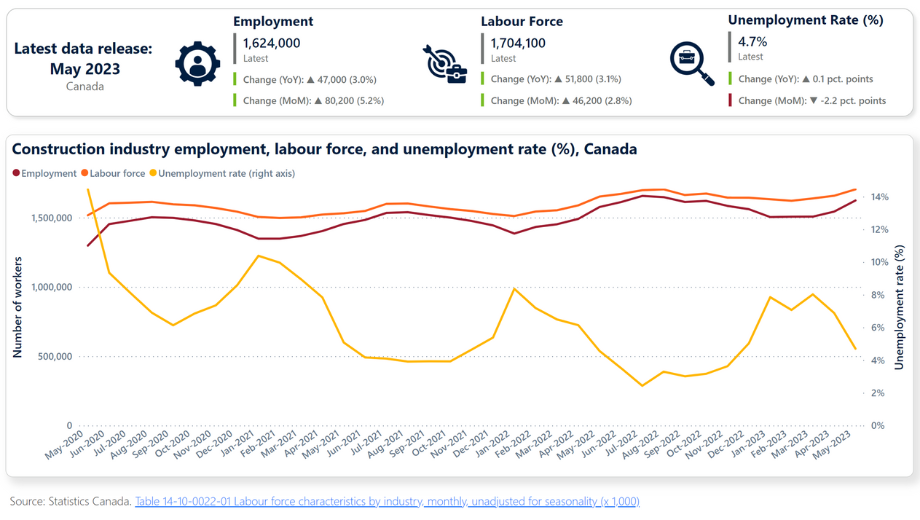The latest Labour Force Survey (LFS) data from Statistics Canada, released on June 9, finds that overall, all-industry employment was virtually unchanged between April and May. Employment contracted by 17,000 (-0.1%) for the month, and has moderated since the beginning of the year. The most recent LFS data shows average monthly employment increases of 33,000 between February and April. Between September and January, employment increased by an average of about 65,200 monthly.
Employment fell by 77,000 (-2.8%) among youth aged 15 to 24, and increased by 63,000 (+0.5%) among people aged 25 to 54.
The employment rate (i.e., the percentage of people aged 15 and older who are employed) declined by 0.3 percentage points to 62.1% in May. This reflected strong population growth in the month (+83,000) and little change in employment.
Meanwhile, the overall, national unemployment rate increased by 0.2 percentage points to 5.2% in May.
Construction labour market tightens as its busy season begins
Building permit data suggests that construction could be preparing for a busy summer ahead. The monthly value of permits reported by Statistics Canada was above $10 billion in each of the first three months of the year, and reached nearly $12 billion in March as a result of strong demand across the industrial, commercial, and institutional sectors. Permit values contracted to $9.6 billion in April, however.

Employment responded accordingly. After remaining largely unchanged for the first three months of the year, seasonally unadjusted employment increased by 36,200 (+2.4%) in April and by a further 80,200 (+5.2%) in May. Growth in the labour force again lagged. The labour force grew by 46,100 (+2.8%) in May, reducing the industry’s unemployment rate to 4.7% (from 6.9% in April).
Compared with May 2022, trends suggest that construction’s labour force may be catching up with employment demands. Over the past 12 months, industry employment grew by 46,800 workers (3.0%), while the labour force added 51,900 workers (3.1%). The industry’s overall unemployment rate increased from 4.5% to 4.7% over the same period.
Construction also continues to add workers among key demographics. Over the last 12 months, the number of core-aged workers in the industry increased from 1.069 million to 1.124 million people. The industry has also reported growth among those aged 15 to 24 years, while the number of workers aged 55 years and over has contracted in the past 12 months.
The number of females employed in construction has also increased over the past 12 months, growing from 194,300 in May 2022 (12% of total industry employment) to 221,900 (14% of total industry employment) in May 2023.
Alberta, Ontario, and Quebec record greatest employment and labour force gains
Alberta (+23,300), Ontario (+21,700), and Quebec (+20.900) reported the greatest monthly gains in employment in May, while British Columbia (-3,600) was the only province to report a contraction in employment. Labour force data followed similar trends, with Alberta (+18,300), Ontario (+11,800), and Quebec (+9,200) reporting the largest absolute gains, and British Columbia reporting the largest contraction (-1,300). Unemployment rates were at or below 5% in five provinces (British Columbia, Alberta, Manitoba, Ontario, and Quebec), while the Atlantic provinces reported rates of between 7.5% (Nova Scotia) and 12.1% (Newfoundland and Labrador).
On an annual basis, by far the largest employment gains were reported in Ontario (+20,700) and Quebec (+20,600). Alberta and Manitoba reported the next-largest employment increases at 9,200 and 5,800, respectively, while the other provinces reported gains of 2,000 or lower. Saskatchewan (-9,300) reported the largest year-over-year employment contraction; Nova Scotia (-4,100) followed.
Labour force trends again followed similar patterns. Ontario and Quebec were by far the largest gainers over the past 12 months at 27,600 and 19,000 respectively. Saskatchewan’s labour force contracted by 9,500, and Nova Scotia’s by 3,400.


Construction Key Indicators
